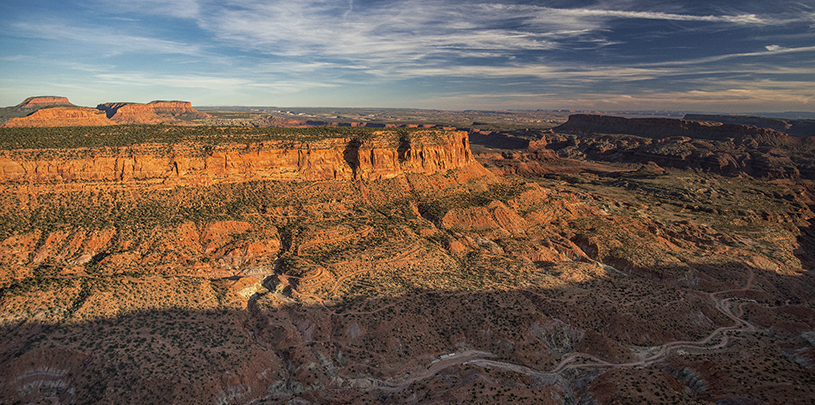
 by Tim Peterson, Cultural Landscapes Director
by Tim Peterson, Cultural Landscapes Director
After six years, there's a speck of light at the end of the tunnel for a legal case challenging Daneros uranium mine, a controversial uranium mine on public lands near Bears Ears National Monument.
Perched below the towering walls of Wingate Mesa above Red Canyon and Fry Canyon, the Daneros Mine site and lands around it were proposed for inclusion in Bears Ears National Monument by the five tribes of the Bears Ears Inter-Tribal Coalition in 2015. When Bears Ears was designated in 2016, Daneros ended up outside the monument’s boundaries, but only by about three miles.
On October 25, 2024, two administrative judges ruled that the federal government's approval of a plan to expand Daneros Mine had violated the law. The judges ordered the attorneys in the case to provide more information so that the judges can determine what the remedy should be.
To refresh your memory, back in 2018 the Grand Canyon Trust and our partners at the Southern Utah Wilderness Alliance finished up briefing an appeal we'd filed before an administrative body called the Interior Board of Land Appeals. We were challenging the U.S. Bureau of Land Management's approval of the mine owner's plan to expand the size of the mine.
The expansion plan called for increasing the mine's surface area tenfold, from 4.5 acres to 46 acres, and for trucking nearly half a million tons of uranium ore through Bears Ears and Natural Bridges national monuments to the White Mesa Mill, near the White Mesa Ute tribal community.
Uranium-ore hauling raises concerns about the risk of accidents and contamination. And uranium mining itself has a history of contaminating water, air, and land.
In its October 25, 2024 decision, the board ruled in our favor, agreeing with us that the mine's plan to expand violated the Federal Land Policy and Management Act by failing to include an adequate monitoring and response plan to detect and manage groundwater from a perched aquifer at the mine site.
Water from the aquifer could potentially infiltrate the underground mine and become contaminated through contact with uranium ore or other harmful materials exposed by mining. The mine site sits above Red Canyon, fewer than 25 miles upstream from the Colorado River on whose water 40 million people depend.
It wouldn't be the first time something like this happened at a uranium mine. Water problems continue to be an ongoing issue at the Pinyon Plain Mine (formerly Canyon Mine), near the Grand Canyon.
Back in 2018, Daneros Mine was owned by Energy Fuels Resources, the same company that owns Pinyon Plain Mine (then known as Canyon Mine) and the White Mesa Mill, but Daneros Mine has changed hands several times over the last six years.
Currently, Daneros Mine owned by IsoEnergy Ltd., a Canadian corporation. However, Energy Fuels continues to act as operator of the mine, and it has a milling agreement with IsoEnergy for the ore dug up at Daneros Mine to be milled at White Mesa.
Daneros Mine operated from 2009 to 2012, producing about 100,000 tons of uranium ore, but with low uranium prices the mine has been on standby since 2012.
In 2023, the mine's owner drilled five exploration holes at the site. According to the company, the core holes "encountered significant uranium mineralization." Earlier this year, IsoEnergy conducted seismic surveys at the site, and says that "results from the geophysical surveys, sedimentological mapping and historic exploration data are expected to be integrated to define new exploration targets for subsequent drill testing.” IsoEnergy appears to see some potential at the mine.
While the board ruled in our favor, it didn't throw out the mine's expansion plan. Instead, it ruled that all parties to the case must file supplemental briefings addressing, among other things, the status of the mine expansion and the practical consequences of vacating the approved mine plan. Our attorneys are hard at work preparing to make our case.
Once the supplemental briefs are done, the board will decide whether or not to throw out the expansion plan. If the board throws out part of the plan, that would mean that certain portions of the project could move forward, but others would be halted, at least temporarily. Or the board could cancel the whole mine plan, which would mean the company could not mine at Daneros and would instead have to go through additional steps to propose a new plan.
As you know, our work to defend national monuments often moves slowly and it's important to celebrate our wins. While this is a small victory, we're happy to be able to share a little bit of good news this holiday season. We'll keep you posted as the case progresses and thank you for sticking with national monuments for the long haul.
A small victory in the legal case challenging Daneros uranium mine, near Bears Ears National Monument.
Read MoreBears Ears petroglyph panels and cultural sites protected by new proposed management plan.
Read MoreA rally in Salt Lake City followed by a spiritual walk in White Mesa demonstrate the Ute community's determination to see uranium mill close.
Read More